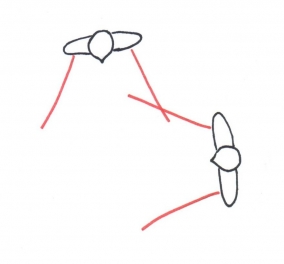Add a comment
Why it’s Harder to Win Over an Audience in Cabaret-Style Seating
‹-- PreviousNext --› The F-formationAs I mentioned a few months ago, my recent adventures in stand-up comedy have been giving me all kinds of new insights into the performance-audience dynamic. Some of the experiences are no doubt peculiar (in both senses) to the genre, but at the same time they shed light onto things I had previously half-analysed but not fully understood.
The F-formationAs I mentioned a few months ago, my recent adventures in stand-up comedy have been giving me all kinds of new insights into the performance-audience dynamic. Some of the experiences are no doubt peculiar (in both senses) to the genre, but at the same time they shed light onto things I had previously half-analysed but not fully understood.
Heckling is pretty firmly in the category of ‘peculiar to stand-up’. Indeed, if you are short of things to entertain you on a long train journey, I can recommend speculating about what form a heckle might take at a recital of Mozart piano sonatas. (That thought lasted me halfway from Durham to Darlington.)
But sitting towards the back of a crowded room at the comedy night at my local pub, I learned all kinds of things about audience-performer relationships from a rather drunk person who was determined to join in.
Now, one of the things we learned on our comedy course is that heckling is usually not a particularly aggressive thing; actually it can be a sign that people are responding to your act, and doing so unselfconsciously. So the etiquette is not to ignore hecklers, but to deal with them and get back to your material. At the same time, you can’t let heckling derail you – the audience haven’t come to listen to the hecklers after all - and persistent interrupters would warrant a response that actively shuts them up.
So far so good. But there was a strange dynamic going on with this particular heckler. It was early in the evening, and the MC was just starting the job of gathering the attention of the audience and getting it focused on the stage. This person towards the back of the room shouted something out in response to something the MC said, so the MC looked over towards him to respond and collect his attention, but he had already turned back to his friends and didn’t listen to the response. This happened a couple of times, and you could see the MC getting somewhat frustrated not to be able to convert these expressions of connection into the attention-gathering effort.
Sitting right near the heckler, it was clear that his focus was on his friends, and that his heckling was a performance for their benefit. That is, the heckler was engaged in his own agenda of attention gathering amongst his immediate neighbours in the room, at odds with that of the main event.
Now, one of my observations in my charisma project has been that traditional concert rituals are designed in several ways to promote the social relationships characteristic of charismatic encounters. One of these is the alignment of seats such that audience members each have an equal and direct access to the performer, but are commensurately isolated from each other.
The specific physical factor here is what gesture-studies maestro Adam Kendon terms the F-formation. This is a social space defined by the intersection of the areas framed by people's hips and shoulders into which they converse, gesture and manipulate objects. The intersection creates a shared space into which they all have access, and this creates the area in which they can converse.
Theatre-style seating lines everyone up in rows so that it’s quite hard to overlap these transactional regions to create an F-formation with the people either side of you, but you have a ready-made one with the stage.
Cabaret-style seating, and the kind of less-formal variants of it you get in pub entertainment spaces, create strong F-formations between audience members, with which the performers on the stage are effectively competing for attention. It is consequently much harder for the performers to create that illusion that their act is creating a whole new world, and for audience members to suspend disbelief and enter into it.
And, whilst you get fewer hecklers in a musical performance (though, now you’ve been thinking up your responses to Mozart, this generalisation may no longer be true), you still get the effect that your attention is much more susceptible to get pulled back to your companions than in theatre-style seating.
Of course, the point about cabaret-style seating is that it allows a structure of event where you get to alternate spending time with your friends and experiencing the entertainment. Three shortish sections separated by intervals, and with social time before and after is a nice way to combine socialising with shared experiences to talk about that night and thereafter. So it makes sense for a comedy night in a way it wouldn’t for, say, a Bruckner symphony.
But it’s still a tough gig.










